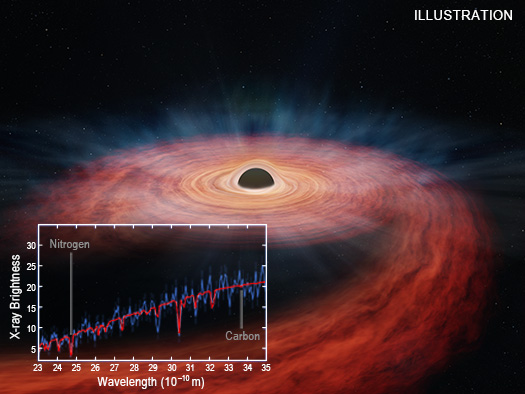For Release: August 22, 2023
NASA/CXC

Credit: NASA/CXC/Univ of Michigan/J. Miller et al.; Illustration: NASA/CXC/M.Weiss
Press Image, Caption, and Videos
Astronomers have made a thorough forensic study of a star that was torn apart when it ventured too close to a giant black hole and then had its insides tossed out into space.
NASA’s Chandra X-ray Observatory and ESA’s XMM-Newton studied the amount of nitrogen and carbon near a black hole known to have torn apart a star. Astronomers think these elements were created inside the star before it was ripped apart as it neared the black hole.
“We are seeing the guts of what used to be a star,” said Jon Miller of the University of Michigan who led the study. “The elements left behind are clues we can follow to figure out what sort of star met its demise.”
Astronomers have found many examples of “tidal disruption events” in recent years, where the gravitational forces from a massive black hole destroy a star. This causes a flare, often seen in optical and ultraviolet light and X-rays, as the star’s debris is heated up. This event, called ASASSN-14li, stands out for several reasons.
At the time of discovery in November 2014 it was the closest tidal disruption to Earth (290 million light-years) discovered in about a decade. Because of this proximity, ASASSN-14li has provided an extraordinary level of detail about the destroyed star. Miller’s team applied new theoretical models to make improved estimates, compared to previous work, of the amount of nitrogen and carbon around the black hole.
“These X-ray telescopes can be used as forensic tools in space,” said co-author Brenna Mockler of Carnegie Observatories and the University of California, Los Angeles. “The relative amount of nitrogen to carbon that we found points to material from the interior of a doomed star weighing about three times the mass of the Sun.”
The star in ASASSN-14li is therefore one of the most massive — and perhaps the most massive — that astronomers have seen ripped apart by a black hole to date.
“ASASSN-14li is exciting because one of the hardest things with tidal disruptions is being able to measure the mass of the unlucky star, as we have done here,” said co-author Enrico Ramirez-Ruiz of the University of California, Santa Cruz. “Observing the destruction of a massive star by a supermassive black hole is spellbinding because more massive stars are expected to be significantly less common than lower-mass stars.”
Earlier this year, another team of astronomers reported the “Scary Barbie” event where they estimated a star with about 14 times the mass of the Sun was destroyed by a black hole. However, this has not yet been confirmed as a tidal disruption, with the estimate of the star’s mass mainly based on the brightness of the flare, not on a detailed analysis of material around the black hole as with ASASSN-14li.
Another exciting aspect of the ASASSN-14li result is what it means for future studies. Astronomers have seen moderately massive stars like ASASSN-14li’s in the star cluster that contains the supermassive black hole in the center of our galaxy. Therefore, the ability to estimate stellar masses of tidally disrupted stars potentially gives astronomers a way to identify the presence of star clusters around supermassive black holes in more distant galaxies.
Until this study there was a strong possibility that the elements observed in X-rays might have come from gas released in previous eruptions from the supermassive black hole. The pattern of elements analyzed here, however, appears to have come from a single star.
Previous work published in 2017 by Chenwie Yang from the University of Science and Technology in Hefei, China, used ultraviolet data from NASA’s Hubble Space Telescope to show that there is enhanced nitrogen compared to carbon in ASASSN-14li, but by a smaller amount than Miller’s team found using X-ray data. Those authors found the star to be only more massive than 0.6 times that of the Sun.
The new paper was published in the August 20, 2023 issue of The Astrophysical Journal Letters and is available here. The other authors of the paper, in addition to Miller, Mockler, and Ramirez-Ruiz, are Paul Draghis (University of Michigan), Jeremy Drake (Center for Astrophysics | Harvard & Smithsonian), John Raymond (CfA), Mark Reynolds (University of Michigan), Xin Xiang (University of Michigan), Sol Bin Yun (University of Michigan), and Abderahmen Zoghbi (University of Maryland).
NASA's Marshall Space Flight Center manages the Chandra program. The Smithsonian Astrophysical Observatory's Chandra X-ray Center controls science operations from Cambridge, Massachusetts, and flight operations from Burlington, Massachusetts.
Media Contact:
Megan Watzke
Chandra X-ray Center, Cambridge, Massachusetts
617-496-7998
mwatzke@cfa.harvard.edu
Jonathan Deal
Marshall Space Flight Center, Huntsville, Alabama
256-544-0034
jonathan.e.deal@nasa.gov


